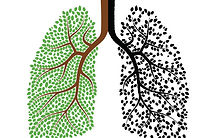COPD
Contact Us: 07957266649
Chronic
Obstructive
Pulmanory
Disorder

information for patients on COPD
emphysema
People with emphysema have difficulty breathing from a limitation in blowing air out.
Emphysema is defined in terms of its pathological features, characterised by abnormal dilation of the terminal air spaces distal to the terminal bronchiole, with destruction of the walls of the air spaces and loss of lung elasticity (MIles & Roberts 2006).
Emphysemas immediate cause depends upon whether it is the first or second of the COPD diseases to appear.
If emphysema develops first it creates an unstable enzyme imbalance within the lungs.
In healthy lungs the enzyme Elastease (created by inflammatory cells macrophages and neutrophils) destroys aging elastin (basic construction material in the lungs providing most of the tissue for the alveoli walls) so they can be replaced by new ones.
To prevent theses enzymes (elastease) from destroying to much elastin our bodies produce a regulatory enzyme alpha-1 antitrypsin in the liver (Hass & Hass 2000), it is released into the plasma where it finds its way to the lungs.
It is the presence of too much elastease and the deficit of alpha-1 antitrypsin that cause the breakdown of the elastin in the walls and surrounding tissue of the alveoli leading to emphysema.
the distribution of the abnormal air spaces allows for classification of the two patterns of emphysema.
-
Panacinar (panlobular) - results in distension and destruction of whole acinus, particularly the lower half of the lungs.
-
Centriacinar (centrilobular) - involves damage around the respiratory bronchioles affecting the upper lobes and upper parts of the lower lobes of the lungs.
Along with an enzyme imbalance emphysema can also appear as a direct result of chronic bronchitis (Barnett 2006). Mucus obstructs airways causing hyperinflation of the alveoli this over distension causes the elastin in the walls of the alveoli to break down , the route from enzyme imbalance is different but the same endpoint is reached.
The destructive process of emphysema is predominantly caused by smoking, cigarette smoke is an irritant and is known to contain 40,000 toxic chemicals (Cancer Reasearch 2014)which cause imbalances to the lungs.
The imbalances caused by inhaling cigarette smoke include;
-
Toxins inhibit alpha-1 antitrypsin limiting their production & usefulness.
-
Causes inflammation which has the effect of producing more elastease.
-
Slows production of new elastic cells.
However emphysema can also be onset by hereditary factors such as inherited alpha-1 antitrypsin deficiency (Campos & Lascano 2014).
A gene on chromosome 141 determines how much alpha-1 antitrypsin is produced in the liver, depending on what each parent has passed on directly effects the amount of alpha-1 antitrypsin produced.
gene pairs and amounts of Alpha-1 antitrypsin produces are as follows
Normal + normal = 100%
Normal + defective = 75%
Defective + normal =75%
Defective + defective =15% (Campos & Lascano 2014)
A person with two defective genes has to little alpha-11 antitrypsin to control the destruction of elastin.
This can account for 2% of cases of sever premature COPD (Campos & Lascano 2014).
Whichever route emphysema develops from the loss of elasticity results in hyper inflated air sacs, this impairs the lungs ability to recoil effectively during expiration.
Eventually the over distended alveoli walls being to break down and merge with other alveoli creating large air sacs (bullae).
Destruction of capillary rich air sac walls means lower amounts of gaseous exchange can take place therefore the respiratory muscles have to work harder.
Since the enlarged alveoli can no longer provide the force which keeps the smaller airways open during expiration, if an airway collapses fibrosis may occour keeping the airway permanently closed. Expiratory resistance increases considerably (Wright, Tazelaar & churg 2011).
Air trapping occurs when the lungs can't rid all the stale air and they can no longer return to their resting position.
Respiratory & cardiac muscles have to work harder on diminishing oxygen supply's which causes extreme fatigue.